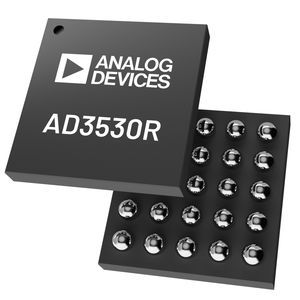

- Products
- Catalogs
- News & Trends
- Exhibitions
High-speed DC/AC converter AD9166 seriesnot specifiedpowerDC
Add to favorites
Compare this product
Characteristics
- Electrical characteristics
- power, DC, high-speed
- Power
4.88 W
Description
DC-coupled, 50 Ω matched output
Up to 4.3 dBm output power, −9.5 dBm at 9 GHz
DAC core update rate: 12.0 GSPS (guaranteed minimum) in 2× NRZ mode
Wide analog bandwidth
DC to 9.0 GHz in 2× NRZ mode (12.0 GSPS DAC update rate)
1.0 GHz to 8.0 GHz in mix mode (6.0 GSPS DAC update rate)
DC to 4.5 GHz in NRZ mode (6.0 GSPS DAC update rate)
Power dissipation of 4.88 W in 2× NRZ mode (10 GSPS DAC update rate)
Bypassable datapath interpolation
2×, 3×, 4×, 6×, 8×, 12×, 16×, 24×
Instantaneous (complex) signal bandwidth
2.25 GHz with device clock at 5 GHz (2× interpolation)
1.8 GHz with device clock at 6 GHz (3× interpolation)
Fast frequency hopping
Integrated biCMOS buffer amplifier
The AD91661 is a high performance, wideband, on-chip vector signal generator composed of a high speed JESD204B serializer/deserializer (SERDES) interface, a flexible 16-bit digital datapath, a inphase/quadrature (I/Q) digital-to-analog converter (DAC) core, and an integrated differential to single-ended output buffer amplifier, matched to a 50 Ω load up to 10 GHz.
The DAC core is based on a quad-switch architecture, which is configurable to increase the effective DAC core update rate of up to 12.8 GSPS from a 6.4 GHz DAC sampling clock, with an analog output bandwidth of true dc to 9.0 GHz, typically. The digital datapath includes multiple interpolation filter stages, a direct digital synthesizer (DDS) block with multiple numerically controlled oscillators (NCOs) supporting fast frequency hopping (FFH), and additional FIR85 and inverse sinc filter stages to allow flexible spectrum planning.
Catalogs
No catalogs are available for this product.
See all of ADI‘s catalogsExhibitions
Meet this supplier at the following exhibition(s):

Related Searches
- DC/DC converter module
- Linear Technology current converter
- Power inverter
- Switching DC/DC converter module
- Inverter for industrial applications
- Current inverter
- DC inverter
- IEC inverter
- Power DC-DC converter
- On-line inverter
- Adjustable DC-DC converter
- Compact AC/DC converter
- RoHS DC/AC inverter
- Programmable DC-DC converter
- Regulator DC-DC converter
- High-speed inverter
- Inverter DC/DC converter
- Voltage output DC/AC converter
*Prices are pre-tax. They exclude delivery charges and customs duties and do not include additional charges for installation or activation options. Prices are indicative only and may vary by country, with changes to the cost of raw materials and exchange rates.


